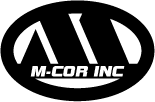
When Quality Counts…in Critical Industries
Buy Direct – Save $
Teflon® Encapsulated O-Rings – CamLock Gaskets – FKM Cord
M-Cor meets AS 568 Tolerances Upon Request
Non-molded O-rings such as encapsulated o-rings (spliced/bonded, hot-vulcanized) are fabricated from extruded cord, so molded AS568/ISO 3601 cross-section tolerances don’t apply; instead, sizing is governed by extruded/length tolerances per ISO 3302-1 and ARPM (formerly RMA). Trelleborg notes that for butt-vulcanized round-cord rings, ISO 3601-1 tolerances apply to the inside diameter but not to the cross-section, providing separate tables for extruded d2 values¹. Parker likewise publishes spliced-ring tolerance guidelines specified by ID or developed length, with limits such as ±0.062″, ±0.125″, ±0.250″, or ±0.5% of DL². Freudenberg/Dichtomatik and James Walker both confirm that extruded cords and cord rings are produced to ISO 3302-1 E-classes rather than molded O-ring tolerances³ ⁴. By contrast, molded O-rings fall under ISO 3601-1 and SAE AS568, which define toroidal tolerances only for molded parts⁵ ⁶. For fabricated/extruded rubber parts in general, dimensional control relies on ARPM MO-1 tolerance tables (extrusion cross-sections and cut lengths)⁷.
References (with links)
- Trelleborg Sealing Solutions — O-Rings & Back-Up Rings (Section D.6 Round cord rings): ISO 3601-1 applies to ID but not cross-section; extruded cord with separate d2 tolerances. PDF
- Parker TechSeal — ParFab™ Design Guide (TSD-5420): Spliced Rings Tolerance Guidelines (ID/DL tolerances). PDF
- Freudenberg/Dichtomatik — Round Cords and Round-Cord Rings: cords extruded; tolerances per ISO 3302-1 E1/E2. PDF
- James Walker — O-Ring Guide: O-ring cord manufactured to ISO 3302-1 (Class E2). PDF
- ISO 3601-1:2012 — O-rings: molded O-ring dimensions/tolerances. Preview PDF
- SAE AS568: Aerospace Size Standard for molded O-rings. SAE abstract
- ARPM (formerly RMA) MO-1 — Rubber Handbook: tolerance tables for extruded cross-sections and cut lengths. PDF
- ISO 3302-1:2014 — Rubber tolerances for extruded products (E & L classes). ISO page
Reference values for min. ID
| (mm) | Core Silicone (mm) | Core FPM (mm) |
|---|---|---|
| 1.78 – 2.40 | 5.28 | 5.28 |
| 2.62 – 3.00 | 6.00 | 6.00 |
| 3.53 – 5.00 | 12.29 | 12.29 |
| 5.33 – 6.30 | 30.80 | 32.80 |
| 7.00 – 20.00 | 63.00 | 76.20 |
Disclaimer: Values without guarantee.



